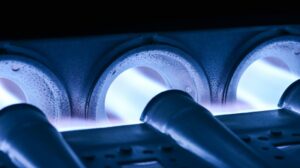If you own a gas-powered furnace, you may not be aware of certain safety risks you need to know about. If you have a furnace that runs on electricity, you may think that your furnace is completely safe because it doesn’t rely on gas.
No matter what type of furnace you own, there are safety issues that you need to be aware of. We don’t want to worry our customers but we also don’t want our customers living in a home with a potentially hazardous furnace which is why we may recommend furnace replacement.
Let’s discuss the safety issues that can arise from owning a gas or electric furnace and how to avoid them.
Potential Gas Furnace Safety Hazards
A gas furnace relies on a combustion process to generate the heat that warms your home. Carbon monoxide gas (CO) is a byproduct of this combustion process. Although your furnace was built to allow CO to safely exit your home, sometimes these safety measures can fail. That’s why your home should be equipped with multiple carbon monoxide detectors if you own a gas furnace.
Carbon monoxide can breach a furnace in the following ways. The exhaust port vents outside your home and can become blocked by debris, tree branches, and even bird nests (the warmth attracts birds). If the blockage is severe enough, the exhaust gas will back up into your home.
Here are some of the signs of a blocked or clogged furnace exhaust port. The furnace won’t emit hot air, it’ll short cycle, you’ll notice unpleasant odors in your home, and the front panel of the furnace will feel hot to the touch.
The Heat Exchanger
The other way that CO can enter your home is if the heat exchanger becomes damaged. The heat exchanger is essential to gas furnaces. The heat exchanger houses the combustion gases and separates the combustion process from the air that you breathe.
Made of metal and constantly subject to wear and tear as your furnace runs, the heat exchanger can wear down over time and develop microscopic cracks that can allow CO to escape.
The signs of a cracked heat exchanger include a furnace that isn’t producing hot air, unpleasant odors such as rotten eggs or sulfur, or a pilot light that’s yellow or orange. Your CO detectors could be going off and household members may be experiencing signs of CO poisoning such as nausea, fatigue, vomiting, and flu-like symptoms
Furnace Maintenance Is Essential for Furnace Safety
The exhaust port and the heat exchanger are things that our NATE-certified Super Techs will check during annual furnace maintenance. They’ll check the exhaust port to make sure it’s free from debris and venting properly, that the heat exchanger is working as it should, and also check for other potential safety issues.
These are rare situations that are more likely to occur in old furnaces that haven’t been tuned-up regularly which is why furnace maintenance is necessary.
At Hagerstown Heating & Cooling, we want to protect customers in Sharpsburg, MD from Google and other contractors in Hagerstown, MD. Honesty at Its Best.

